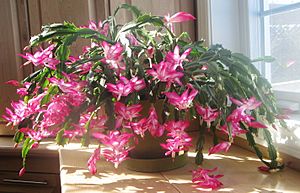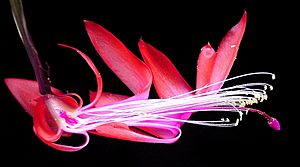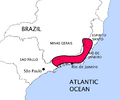Christmas cactus facts for kids
Quick facts for kids Schlumbergera |
|
|---|---|
 |
|
| Cultivar belonging to the Schlumbergera Truncata Group | |
| Scientific classification | |
| Kingdom: | |
| (unranked): | |
| (unranked): | |
| (unranked): | |
| Order: | |
| Family: | |
| Subfamily: | |
| Tribe: |
Rhipsalideae
|
| Genus: |
Schlumbergera
Lem.
|
| Species | |
|
|
Schlumbergera is a small group of cacti with six to nine different types, called species. You can find them in the coastal mountains of south-eastern Brazil. These plants grow on trees or rocks in places that are usually shady and very humid. They look quite different from the cacti you might imagine growing in a desert!
Most Schlumbergera species have stems that look like flat, leaf-like pads joined together. Their pretty flowers grow from special spots called areoles, found at the joints and tips of the stems. A couple of species have round, cylindrical stems, more like other cacti.
These cacti are often called by names that relate to when they bloom. In countries like the USA, they are known as Christmas cactus, Thanksgiving cactus, crab cactus, or holiday cactus. In Brazil, they are called Flor de Maio, meaning "May flower," because that's when they flower there.
Most of the popular Schlumbergera plants you see in homes are not wild species. Instead, they are special types created by growers, called cultivars. Their flowers come in many colors, like white, pink, yellow, orange, red, or purple. The Easter cactus is another holiday cactus, with flowers in red, orange, pink, and white. It used to be in a different group but is now sometimes included with Schlumbergera.
Contents
What are the main types of Christmas cactus?
The popular Christmas cactus cultivars fall into two main groups:
- The Truncata Group includes all cultivars that mostly get their features from the S. truncata species.
- Their stem segments have pointed "teeth."
- Their flowers usually point upwards or sideways.
- The top and bottom parts of their flowers look different (this is called zygomorphic).
- Their pollen is yellow.
- These usually flower earlier. They are often called Thanksgiving cactus, crab cactus, or claw cactus.
- The Buckleyi Group includes cultivars that show features from the S. russelliana species.
- Their stem segments have rounded, more even "teeth."
- Their flowers are more or less symmetrical and hang downwards.
- Their pollen is pink.
- These usually flower later. They are more likely to be called Christmas cactus.
How do these plants look?
In the wild, Schlumbergera species grow either on trees (these are called epiphytes) or on rocks (called epilithic plants). They can grow into large shrubs with woody bases. One species, S. opuntioides, has even been reported to reach a height of about 4 feet (1.2 meters)!
These plants don't have leaves. Instead, their green stems do the job of photosynthesis, which is how plants make their food. The stems are made of segments. Most species have flat segments, like pads, with a central part and two (or sometimes three) "wings." Special cactus structures called "areoles" are found at the ends of these stem segments.
Two species have stems that are less flat and more cylinder-shaped. Their areoles are arranged in a spiral pattern all over the segments. In all Schlumbergera plants, the areoles are where the flower buds appear. These spots might also have some soft wool or bristles.
What do their flowers look like?
The flowers of Schlumbergera can either hang downwards and be almost perfectly round (radially symmetrical). Or, as in most species, they are held more or less sideways, with the top part of the flower looking different from the bottom part (radially asymmetrical or zygomorphic). For flowers that point sideways, their angle is usually the same for each species.
Each flower has 20 to 30 petals, called tepals. The outer tepals, closer to the flower's base, are short and separate. They spread out or curve backward. The inner tepals, towards the flower's tip, are longer. In most species, these inner tepals join together at the base to form a tube, called a floral tube. Sometimes, the difference between the outer and inner tepals makes it look like there's a "flower within a flower." These flowers also make a sweet liquid called nectar in a small chamber at the base of the floral tube.
Most species have many stamens (the parts that produce pollen) arranged in two rows. The inner stamens are joined at their base, forming a short tube. The outer stamens grow from along the floral tube. The style (the part that receives pollen) is usually dark red and has 6 to 8 lobes. The style and stigma are about the same length as the stamens. If the flower is fertilized, a fleshy fruit grows. This fruit can be smooth or have ribs. Inside, the brown or black seeds are very tiny, about 1 millimeter across.
Images for kids
-
Drawing of S. russelliana, the type species, from the Botanical Magazine, 1839
-
Schlumbergera new growth. The upper view shows bright red new cladodes forming, the centre shows maturing growth, the lower view shows two aerial roots extending down
See also
 In Spanish: Schlumbergera para niños
In Spanish: Schlumbergera para niños









